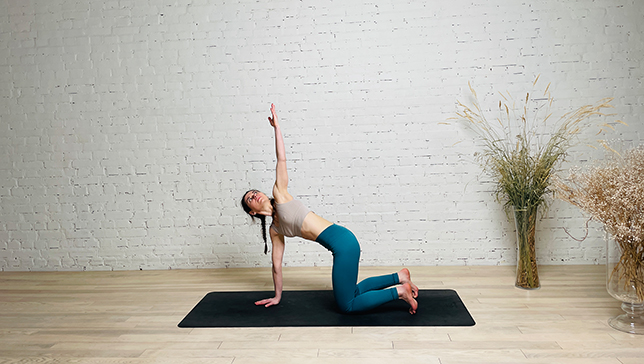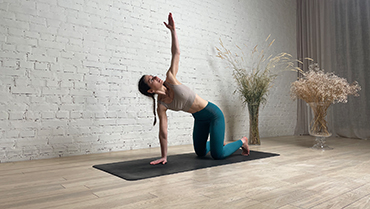Revolved Table Top Pose One Hand Raised - Parivrtta Bharmanasana Urdhva Eka Hasta

Contents
Revolved Table Top Pose One Hand Raised or Parivrtta Bharmanasana Urdhva Eka Hasta in Sanskrit (Parivrtta means “to turn around” or “revolve”, Bharmanasana means “Table Top Pose”, Urdva stands for “Up”, Eka – “One”, and “Hasta” means “hand”) is a beginner level yoga pose that provides a nice spinal twist and shoulder stretch.
Parivrtta Bharmanasana Urdhva Eka Hasta works with the following muscles groups:
Arms and Shoulders
Upper Back Biceps and Triceps
Core (Abs)
Chest
Knees
Neck
Psoas
Pose Detail
- Body Position: Arm & Leg Support, Twist Yoga Poses
- By Type: Balancing Yoga Poses, Chest Opening Yoga Poses, Flexibility Yoga Poses, Shoulder Opening Yoga Poses, Strengthening Yoga Poses
- Difficulty: Beginners
- By Benefit: Yoga Poses For Neck Pain, Yoga Poses For Stress Relief
Step-by-Step Instructions
Benefits and Contraindications
improves spinal mobility
reduces back pain and stiffness
improves posture
enhances overall flexibility and range of motion
Hip, shoulder, spine, or knee surgeries Injury or surgery
Photo poses in different angles

Modifications and Props
If you have sensitive knees use yoga knee pads or a blanket underneath your knees to reduce discomfort and pain during pose performance.
Using yoga knee pads or a blanket can be a great way to make your Parivrtta Bharmanasana Urdhva Eka Hasta practice more comfortable and enjoyable, while also reducing your risk of injury. If you’re new to yoga or have sensitive knees, it’s definitely worth giving them a try.
Frequently Asked Questions
A Revolved Table Top Pose One Hand Raised can be beneficial for anyone looking to improve their spinal mobility, including those who spend long periods of time sitting or standing, those with back pain or stiffness, and athletes or active individuals who want to improve their overall flexibility and range of motion.
The frequency of a thoracic spine twisting like in Revolved Table Top Pose One Hand Raised depends on individual needs and goals, but it is generally recommended to practice 2-3 times per week for optimal results. It is also important to listen to your body and not overdo it, especially if you are new to these exercises or poses.
Common exercises or poses in a thoracic spine twisting sequence include seated or standing spinal twists, supine twists, and yoga poses such as seated spinal twist (Ardha Matsyendrasana) and Revolved Triangle Pose (Parivrtta Trikonasana).